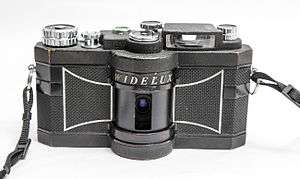Widelux
The Widelux is a fully mechanical swing-lens panoramic camera first developed in Japan in 1958,[2] by Panon Camera Shoko. There are both 35mm and medium-format models. Instead of a shutter, the camera has a slit that exposes the film as the lens pivots on a horizontal arc. This pivot allows for some distortion effects not available with traditional cameras. The last Widelux model F8 ended production in 2000. [2]
 Widelux model F7 | |
| Overview | |
|---|---|
| Maker | Panon Camera Shoko |
| Type | swing-lens panoramic camera |
| Lens | |
| Lens | 26mm pivoting lens |
| F-numbers | 2.8, 4, 5.6, 8 and 11 |
| Sensor/medium | |
| Film format | 35mm |
| Film size | 24mm x 56mm |
| Focusing | |
| Focus | Set at 5-6 feet |
| Exposure/metering | |
| Exposure | 1/15, 1/125, 1/250 |
| Exposure metering | No |
| Flash | |
| Flash | No |
| Shutter | |
| Shutter speeds | 1/15, 1/125, and 1/250 |
| Viewfinder | |
| Viewfinder | Yes |
| General | |
| List price | about US$750 in 1988[1] |
| Made in | Japan |

Models
Widelux F series 35mm
- Widelux FI (1959) with Vistar f/2.8 26mm
- Widelux FV (1959) with Panon f/2.8 26mm
- Widelux FVI (~1964)
- Widelux F6 (~1970)
- Widelux F6B (~1970s)
- Widelux F7 (1979–1988)
- Widelux F8 (1988–2000)
Medium Format model 1500
The medium format Widelux model 1500 make 50x122 mm frames on 120 film, and cover a 150-degree horizontal angle across the long side. It was described as newly introduced in 1988 and cost "about US$4,500" at the time.[1]
Differences
There are important differences between the F and 1500 series cameras. The 35mm cameras have a set focus (5 ft to infinity), whereas the 1500 Widelux can focus from a bit less than 1m to infinity with seven markers. The 35mm cameras have three shutter speeds, 1/15, 1/125 and 1/250 of a second, whereas the 1500 Widelux has shutter speeds of 1/8, 1/60 and 1/250 of a second. The F series cover a 140 degree view, whereas the 1500 series covers a slightly wider area (150 degree view-diagonally-140 degr.horizontally). Finally, the 1500 Widelux, like most manual film cameras, has a shutter that must be cocked before the camera will fire. When setting focus below 5m on Widelux 1500 the resolution will be reduced due to optical limitations. There were a lot of problems for the first models in the 90s, uneven rotation, filmplane so buyers are encouraged to test beforehand.
Users
Actor/photographer Jeff Bridges started photographing movie sets with the camera in 1984. In 2003, he published a book of his panoramic pictures called simply "Pictures".[3] Bridges was recognized for his Widelux photography by the International Center of Photography's Infinity Award in 2013.[3]
A few of filmmaker Stanley Kubrick's Widelux photos appear in the book "Stanley Kubrick: A Life in Pictures" by his wife Christiane.[4]
The Widelux has been used on some NASA missions for its 140° coverage.
Similar cameras
Cameras with similar functions include the Noblex and Horizon.
References
- Meehan, Joseph (October 1988). "Superwide: A user's guide to the world of super wide-angle lenses and panoramic cameras". Popular Photography. 95 (10): 56–61, 82–83. Retrieved 3 April 2015.
- "Widelux". Camerapedia. Retrieved 3 April 2015.
- Estrin, James (30 April 2013). "Lens Blog: The Dude Abides on the Other Side of the Lens". New York Times. Retrieved 3 April 2015.
- Christiane Kubrick (2002). Stanley Kubrick: A Life in Pictures. Retrieved 3 April 2015.
Stanley took this photograph in the Dorchester Hotel ... in early 1965 ... he shot it with one of his favorite cameras: the 35mm Widelux.